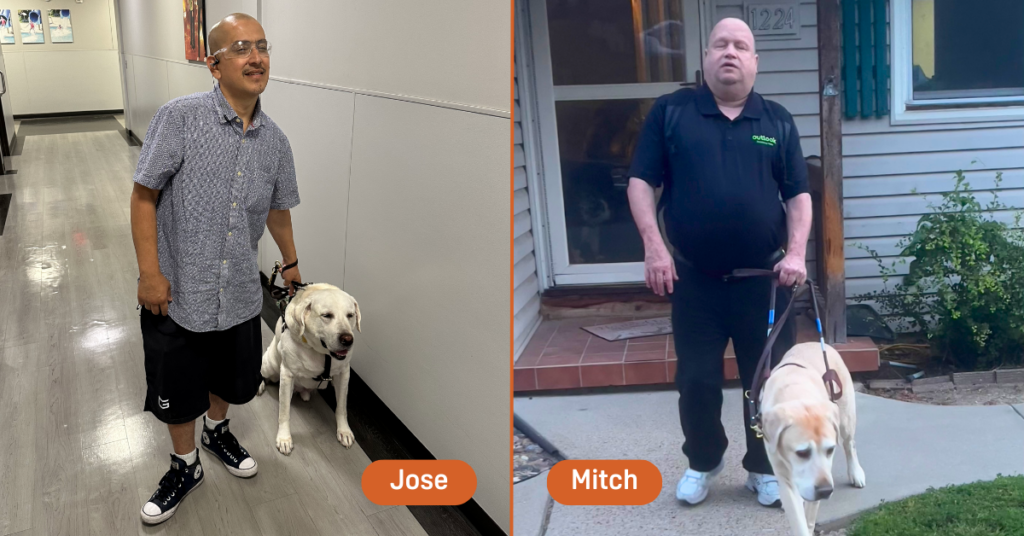
Guide dogs are an invaluable and trustworthy option for blind or low-vision individuals seeking to enhance mobility and safety. In recognition of National Guide Dog Month this September, we’re sharing tips for interacting with guide dogs and personal stories from two Outlook associates about their journeys beyond vision and experiences with guide dogs.
Understanding the Role of Guide Dogs and Proper Etiquette
Every service dog serves a distinct purpose, and guide dogs are no exception. They are trained to assist individuals who are blind or have low vision with mobility. While both guide dogs and emotional support dogs play vital roles and are trained to aid their owners in times of need, there are critical differences in their accommodations.
Under the Americans with Disabilities Act (ADA), state and local governments, businesses, and nonprofit organizations that serve the public must allow service animals to accompany people with disabilities in all areas where the public is permitted. In contrast, an emotional support animal (ESA) is not considered a service animal under the ADA because its assistance is not directly related to an individual’s disability. Different regulations apply to individuals with ESAs, which are protected by federal and state laws. To qualify for an ESA, owners must obtain a letter from a licensed mental health professional, which may be required for travel and housing under the Air Carrier Access Act and Fair Housing Act.
Proper etiquette for interacting with guide dogs is essential. They are always considered “at work” and should not be distracted or petted.
Here are some important guidelines to follow:
- Approach with caution: Address the owner calmly to avoid startling them.
- Maintain your distance: Allow the dog enough space to perform its duties. Remember, guide dogs always have the right of way.
- Don’t offer treats: Avoid giving guide dogs treats, as this can be distracting.
- Don’t issue commands: Refrain from giving commands to guide dogs or grabbing their leash.
- Assist only upon request: Offer assistance only if the owner requests it or consents. Pulling or steering the owner without permission can create confusion and violate their personal space.
- Be considerate: Always address the owner, not the dog.

Empowerment Through Partnership: Jose Castañeda and Tiberius
A few years after relocating to Omaha with his family to escape gang-related violence in Los Angeles, 20-year-old Jose Castañeda was involved in a car accident that temporarily blurred his vision, making everyday tasks much more difficult. The accident shed light on the genetic condition that he was born with, known as retinitis pigmentosa (RP). Growing up, he was aware of his mother’s vision loss but didn’t know what RP was or the challenges it could bring.
Fortunately, his sight returned after a few months, allowing him to continue driving for another 10 to 15 years. However, as his condition progressed, Jose eventually faced the difficult decision to stop driving to prioritize his safety. Reflecting on the accident, Jose believes it may have triggered or accelerated the effects of his RP, leading to a more rapid decline in his vision. With the help of an eye doctor, he gained a deeper understanding of RP and how it would potentially impact his future.
Jose’s vision loss eventually led him to seek employment on the manufacturing floor at Outlook Nebraska, where he has been for over twenty years. He started his career with First Star Fiber before Outlook Nebraska transitioned into a separate organization in 2002. While working at Outlook, another associate suggested that a guide dog might benefit him. Jose explained that he struggled with cane travel, as his partial vision often made him second-guess the cane’s guidance. He found himself wanting to rely on the vision he had left, which led to a lack of confidence in his navigation. This was a pivotal moment in his journey beyond vision as he realized a guide dog would offer greater independence and boost his confidence in his mobility.
The process for applying for a guide dog was straightforward, requiring him to select an agency to go through (The Seeing Eye), complete an application, and submit references. Upon approval, they flew him to Morristown, NJ, to begin training, which took four weeks for his first dog and three weeks for his current dog, Tiberius. Jose says, “They can be a lot of work, but it’s well worth it.” Jose continues to use clicker training to help Tiberius get accustomed to a new environment he will frequent. Jose says, “We are like a team. We have to work together. At work, he knows everyone and is friendly. But when we travel, he works 110%. He doesn’t stop and say hi. He’s working hard and knows we are on a mission.”
Curiosity Creates an Expert Handler: Mitch Green and Anakin
Just as every journey with vision loss is unique, so is every owner’s experience and reasoning behind applying for a guide dog. Mitch Green, Outlook’s IT Manager, has been with us for 13 years and is now on his third guide dog (Anakin), making him an expert with the process. Due to his premature birth, Mitch has been blind his entire life. His experience with guide dogs started when he was 19 when he had the opportunity to head to Florida to work with Henter-Joyce (now Freedom Scientific today), the creators of JAWS.
One afternoon, he joined co-founder Ted Henter for a trip to the beach. As Mitch ventured towards the water, something remarkable happened – Henter’s guide dog instinctively tried to guide Mitch back to shore. This was unusual, as guide dogs typically form a strong bond with their owner and are trained only to guide them. However, Mitch explained that Henter and his dog struggled to connect. This moment sparked Mitch’s curiosity about guide dogs and the process of obtaining one. As a result, Mitch applied at Guiding Eyes for the Blind in New York and was accepted when he turned 21.
He recalls the process, which required references, a physical exam, and details about his home environment. After applying, a field representative visited his home to verify his address and ensure it was safe for a guide dog. Mitch underwent four weeks of intensive training and was paired with his first guide dog, Upton. During training, the instructors took his cane away, allowing him to focus entirely on navigating with Upton and getting familiar with the facility. Mitch also trained on the busy streets of New York, stating, “If I could navigate there successfully, I knew I could travel anywhere.”
During training, instructors assess each trainee’s walking speed, the strength of pull required for directional guidance, and their responsiveness to cues, including stopping. This information helps the organization to create a detailed profile for each trainee to ensure an accurate match with a potential guide dog. While guide dogs are specifically trained for mobility purposes, Mitch noticed that his current dog, Anakin, started to detect fluctuations in his blood sugar levels over time. He believes their strong bond has enabled him to recognize these changes. He has found Anakin fairly accurate, often alerting him before his insulin monitor goes off.
Today, the total cost of travel and training for a guide dog can reach up to $50,000. Fortunately, numerous nonprofit organizations in the United States offer these services at no cost to owners. While each owner’s reasons for getting a guide dog may differ, they offer more than just enhanced mobility—they can boost confidence, foster independence, and provide valuable companionship. Although, it’s important to remember that they are a significant responsibility. Despite potential challenges, as Jose and Mitch can attest, the benefits outweigh the challenges. To learn more about Outlook Enrichment’s services and programs, contact us at 531-365-5051.


